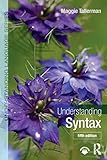Understanding syntax / Maggie Tallerman.
Material type: TextSeries: Understanding language seriesPublisher: Abingdon, Oxon : Routledge, 2020Edition: Fifth editionDescription: vi, 349 pages ; 25 cmContent type:
TextSeries: Understanding language seriesPublisher: Abingdon, Oxon : Routledge, 2020Edition: Fifth editionDescription: vi, 349 pages ; 25 cmContent type: - text
- unmediated
- volume
- 9780367198404
- 415 T145u 23
- P291 .T3 2020
| Item type | Current library | Shelving location | Call number | Copy number | Status | Date due | Barcode | |
|---|---|---|---|---|---|---|---|---|
 Books
Books
|
Main Library-Nabua | Circulation Section | CIR 415 T145u 2020 (Browse shelf(Opens below)) | 1-2 | Available | 023022 | ||
 Books
Books
|
Main Library-Nabua | Circulation Section | CIR 415 T145u 2020 (Browse shelf(Opens below)) | 2-2 | Checked out | 10/09/2024 | 026427 |
Includes bibliographical references and index.
What is syntax? -- Words belong to different classes -- Looking inside sentences -- Heads and their dependents -- How do we identify constituents? -- Relationships within the clause -- Processes that change grammatical relations -- Wh-constructions: questions and relative clauses -- Asking questions about syntax.
"Assuming no prior grammatical knowledge, Understanding Syntax explains and illustrates the major concepts, categories and terminology involved in the study of cross-linguistic syntax. Taking a theory-neutral and descriptive viewpoint throughout, this book: introduces syntactic typology, syntactic description and the major typological categories found in the languages of the world; clarifies with examples grammatical constructions and relationships between words in a clause, including word classes and their syntactic properties; grammatical relations such as subject and object; case and agreement processes; passives; questions and relative clauses; features in-text and chapter-end exercises to extend the reader's knowledge of syntactic concepts and argumentation, drawing on data from over 100 languages; highlights the principles involved in writing a brief syntactic sketch of language. This fifth edition has been revised and updated to include extended exercises in all chapters, updated further readings, and more extensive checklists for students. Accompanying e-resources have also been updated to include hints for instructors and additional links to further reading. Understanding Syntax is indispensable for students studying the description of language, cross-linguistic syntax, language typology, and linguistic fieldwork"-- Provided by publisher.
There are no comments on this title.

